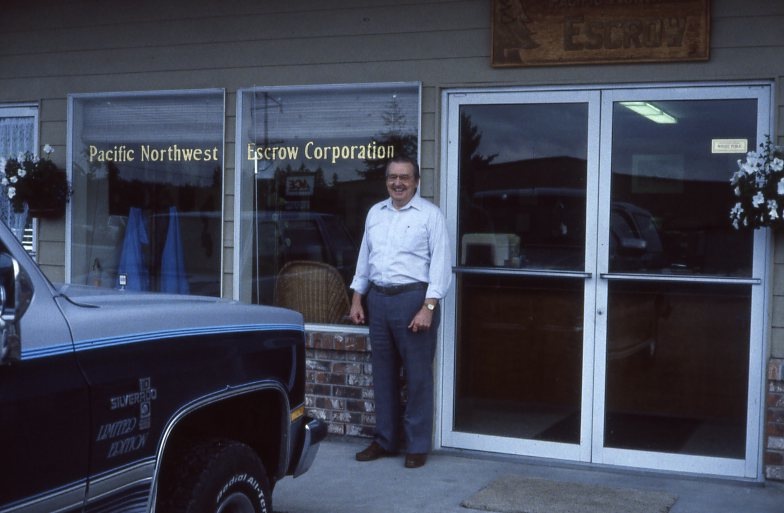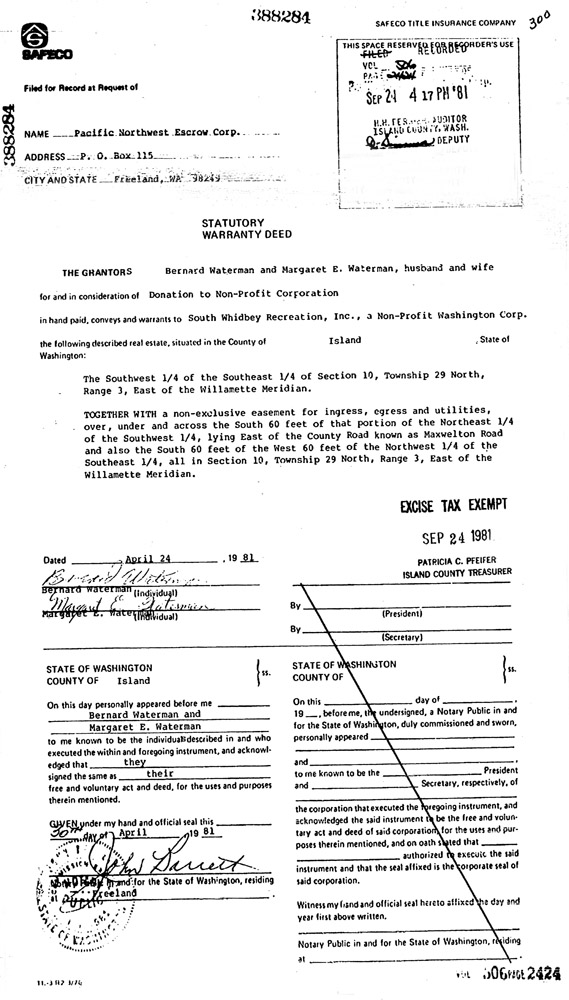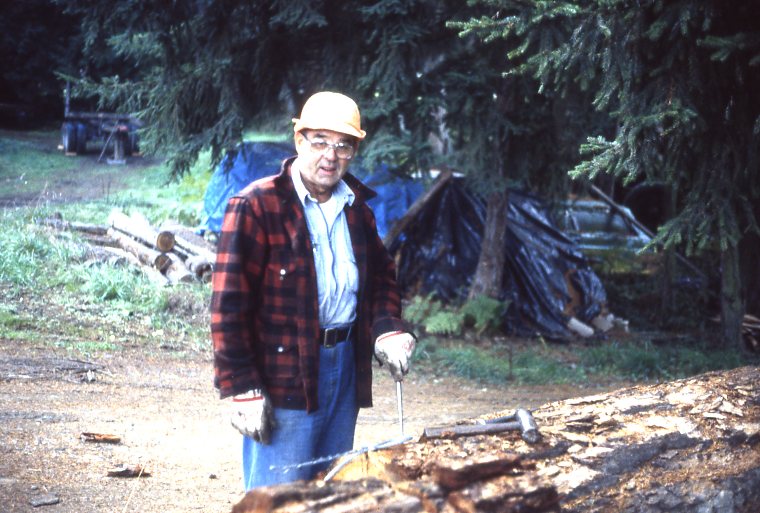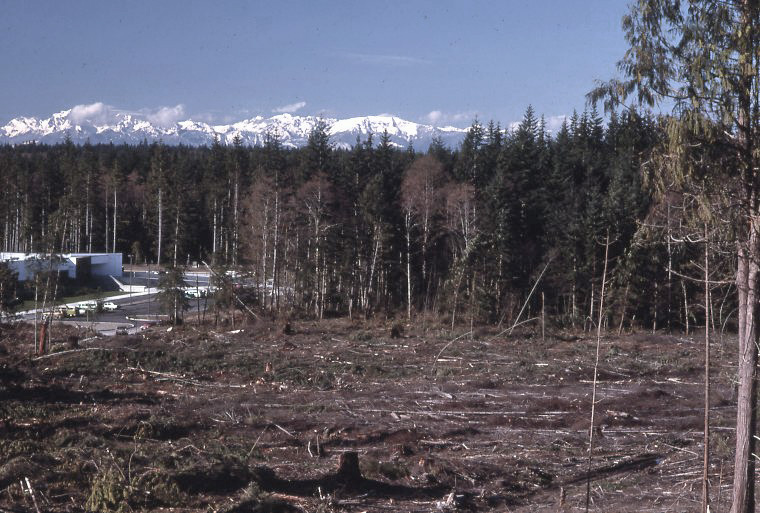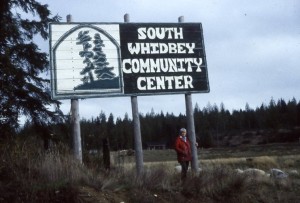
Judy McVay standing beside the sign that she and others made to identify the South Whidbey Community Center site. Value $3,000.
This is the story of a dream, realized by the coming together of the community to build a forty-three acre community park complex for all to enjoy and cherish. The journey started with one man, Tim Scriven, but many joined together along the way in order to make the endeavor a great success. From acquiring the land to finalizing its development an eight year period of time was required.
For almost two years Tim Scriven had shared his vision of building and developing a single community site where different age groups could meet and interact in common interest areas. The complex would provide building sites for well-established nonprofit organizations that would construct and maintain their own facilities.
November 1980. But the first task was to search for a good site to develop the complex. Ad hoc meetings were organized by Tim Scriven with the goal of selecting and then purchasing 30 to 40 acres for the Community Center site. The initial ad hoc committee members were Bruce Groom, Steve Shapiro, Jim Porter, Bruce Anderson, Tony Shults, Wally Lehman, Scott Mickelson, Mike Shelton and Tim Scriven. The group realized that an organization needed to be formed to carry out the mission. Judy Yeakel explained the need for Articles of Incorporation and establishing a nonprofit corporation. In January 1981 attorney Adolph Koch donated his services to file Articles of Incorporation for a non-profit organization named South Whidbey Recreation.
In January 1981, Tim Scriven sought the advice of Siegfried Semaru, the Director of Recreation for the City of Bellevue, and traveled to Bellevue to meet him in his office. The advice which Siegfried offered was to locate next to a school site, find property in the center of the service area so that the facilities would be equally accessible, and to “Ask the land what it wants to be?” meaning the land should have certain topographic and drainage characteristics that would be suitable for the kind of development envisioned for it. Siegfried Semaru’s advice was utilized by Tim Scriven as he located six potentially suitable sites. Tim walked the parcel which best represented the criteria for a community center complex in order to assess its topography and drainage characteristics. The property appeared to be ideal and Tim approached the owners.
February 1981. The preferred site belonged to Bud and Margaret Waterman, owners of Waterman Mill Co., Inc. Bud had spoken with Tim several months before regarding Tim’s vision for a community center complex. Tim called Bud and made an appointment with him to discuss the purchase of the forty-three acre tract which the Waterman’s owned next to where the South Whidbey High School wasbeing built. The South Whidbey High School site had been donated by the Waterman’s several years before.
During Tim’s meeting with Bud, Bud offered to sell the property for $80,000 cash using an option agreement and 60 days was provided to raise the money. Tim knew that it was foolish to attempt to try to raise that much cash in such a short time period, especially without any assets or a formally established organization to work with and certainly he was concerned about failing while attempting such a seemingly impossible task. In spite of the odds against him, Tim said a silent prayer and accepted Bud’s offer.
Waterman Mill office
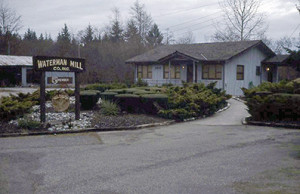
Waterman Mill office where the option agreement to purchase the South Whidbey Community Center site was signed by Bud Waterman and Tim Scriven February 27, 1981.
Option agreement
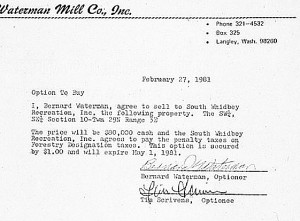
Option agreement
The option agreement was drafted by Bud Waterman’s daughter Debra and was signed on February 27, 1981. Tim called a meeting of the ad hoc committee and revealed what had occurred. Soon after Mike Shelton went to the forty-three acre site and dug several soil log holes with his back hoe to provide some additional insight into the drainage characteristics of the land. The tests were positive.
April 1981. How could we pay for the purchase? Within 45 days 36 couples and individuals had given $250 each toward the purchase of the Community Center site. Wally and Betty Lehman gave $2,000 and 15 others donated various amounts. The effort from the donors was exceptional in such a short time but the amount raised, about $15,000, was far short of the required goal and therefore Tim Scriven called a meeting to announce that the effort to buy the land had failed and the money should be returned.
Scotty Michelson suggested that it might be possible to log the site and said that he would cruise the property to see what the timber was worth. Scotty Michelson visited the site and reported that there was enough value in the timber to more than pay the option amount without taking all of the trees. Scotty estimated seventy percent would need to be logged. Scotty said that using his cruise results it might be possible to get a loan from Whidbey Island Bank to pay for the property, the loggers and fulfill the terms of the option agreement. This information made it possible for the purchase of the forty-three acre park site to become a reality!
Original Donors
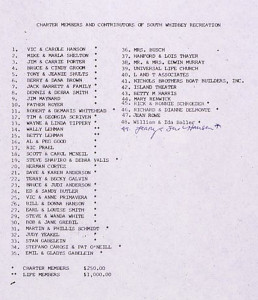
Original Donors – 36 couples and individuals gave $250 toward the purchase of the Waterman 43 acre site to raise $80,000 cash and preform on the option agreement. 15 other individuals, groups and businesses gave amounts ranging up to $200.
Tim Scriven reported Scotty’s finding to Waterman Mill and they invited Orvin Tveit, a forester from Weyerhaeuser Company, to come over and cruise the property. The second timber cruise also determined that clear-cutting seventy percent of the timber would net enough to pay the option amount. The original option agreement was set aside, Waterman Mill clear cut seventy percent of the timber where designated and then donated the property to South Whidbey Recreation. This arrangement was coordinated by Tim Scriven on a verbal agreement and a hand shake with Debra Waterman representing her parents. The formal donation took place on September 1981, attorney Ross Jacobson contributed greatly to the process. Special thanks are due to Pacific Northwest Escrow and Island Title for donating their time to the escrow and transfer of title. The money that community members, organizations and several others had given toward the purchase of the property was now set aside to be used for hard cost expenses in developing the land.
Orvin Tveit’s cruise of the Timber April 14, 1981.
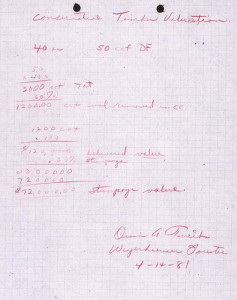
Orvin Tveit’s cruise of the Timber April 14, 1981. Logger Scotty Mickelson was the first to report that there was enough Timber on the 43 acre site being purchased to pay the option amount with a clear cutting of just 60% of the site.
A detailed account of income received and money spent was carefully recorded in the check book register of the nonprofit organization, South Whidbey Recreation. When South Whidbey Recreation was dissolved the check book register was placed in the possession of the newly formed Park District. Retired engineer, Joe Putnam had been treasurer of South Whidbey Recreation during its existence and was also involved in variety of volunteer projects that were accomplished at the park site. Joe had done a nice job of accurately keeping the records up to date.
In April 1981, a boundary survey was accomplished.
June 1981 to February 1982. Now the use for the site that was to be developed needed to be determined in more detail and for that we needed to poll the residents of the community. The Western Washington University Recreation Department students, under the direction of Dr. Jim Moore, executed a Recreation Preferences Survey at the request of Tim Scriven and on behalf of South Whidbey Recreation. WWU published the study, which served as a valuable tool in the planning of the South Whidbey Community Center. The Quorum of Bellevue, owned by Tony Shults and Jon Thomas, donated their companies’ time and facilities to the graphics, layout and printing of the Preference Survey Booklet. The preferred uses were numerous, but the main benefits of the survey were to raise awareness and increase credibility of the project.
About this time a much needed logo for the proposed community park complex was created and donated by graphic designer, Tony Shults. It continues to serve as an invaluable symbol of recognition for the South Whidbey Park and Recreation District and what it represents and provides to the community.
Now we were ready to clear the land! Or so we thought.
February 1982. Jack Siebert, owner of Tri-County Land Survey, directed a topographic survey at 2 foot contour intervals at the request of Tim Scriven who organized a volunteer work force for Jack. Jack Siebert donated his time to do the topographic survey. Then, Hanford Thayer donated his engineering expertise and created a grading plan from the survey for construction of the athletic fields and to secure the required permits.
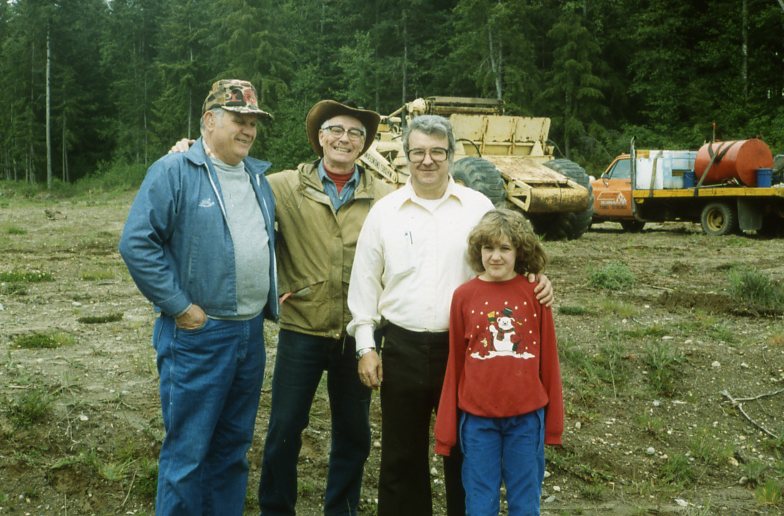
Joe Putnam, Hanford Thayer and Jack Siebert & daughter Shannon.
Randy Bradley worked with Hanford and Tim to plan the initial site clearing and slash burning. Randy was always available for whatever the project or the situation called for. He maintained a high level of enthusiasm for eight years, giving generously with his wife Myrna and stepsons Mike and JT Madsen.
At the request of Tim Scriven, attorney Ross Jacobson donated his time and persuaded Island County to eliminate a fee of $10,000 for back forestation taxes. Special thanks to the Prosecuting Attorney Dave Theile whom Tim Scriven contacted initially and who expressed an interest in working to resolve the problem.
Ross gave his time to the acquisition of the park’s property site and to the establishment of the nonprofit organization, South Whidbey Recreation, and then its dissolution upon voter approval of the South Whidbey Park and Recreation District.
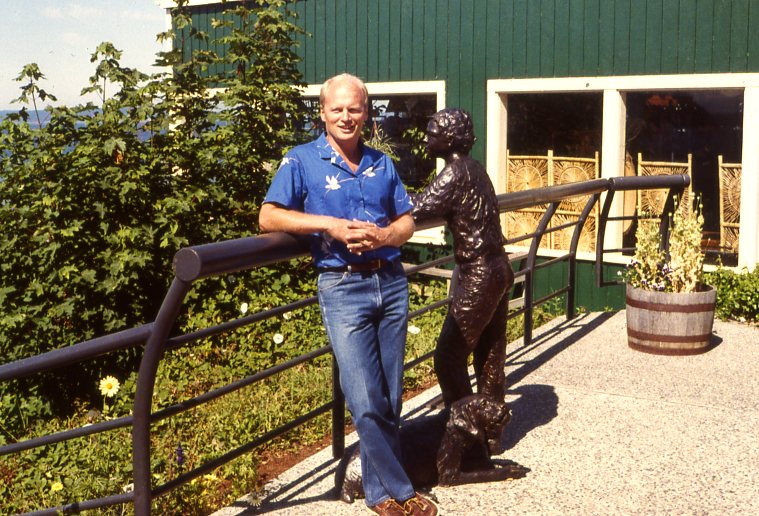
Attorney Ross Jacobson who donated approximately $12,000 of his professional time toward various projects during the first couple of years.
Ross once told Tim Scriven that if one child benefited from his investment of time, it was time well spent. Amazingly it was time spent in concert with the contributions of other professionals who also gave very significantly, most likely with the same type of motivation in mind. One by one they cooperated to build the park complex over an eight year period of time. Each of them was inspired by the hope of influencing the life of one child in a positive way through creating a venue where the age groups would interact.
When the forty-three acre property site was acquired from the Waterman’s following the purchase/donation process an easement to the northwest corner was included. It was recognized that an easement to the southwest corner would be highly desirable.
Tim Scriven spoke to both Arthur (Johnny) and Dora Gabelein and to the South Whidbey School Dist. about cooperatively sharing the adjacent easements that they each owned going from Maxwelton Road to the southern boundary of the park site. All agreed and the easements were put together for the common use of the Gabeleins, the School District, and the community park then owned by South Whidbey Recreation.
Attorney Ross Jacobson donated his professional time to draft the necessary agreements. Pacific Northwest Escrow and Island Title worked cooperatively with Ross during the process as needed.
The purchase of the property and planning the project were complete. The uses of the property resulting from the preferences survey were yet to be determined, but it was envisioned that long term leases would be signed for one dollar per year for qualified 501 C-3 groups. Systems such as roads, power, telephone and drainage would be developed by the South Whidbey Park and Recreation District which would also hire a director to manage and coordinate the Community Center complex. A letter dated Oct. 20, 1983 was written by Island County Prosecuting Attorney David Thiele explaining the feasibility of a Park and Recreation District to work cooperatively with Community organizations to facilitate funding and operation of the community center complex. (See Appendix)
The Parks and Recreation District would also participate in other ways as necessary and all facilities would be available to the general public. Using these approaches non-profit organizations would continue to benefit from their network of volunteers and private donations. As a result a great deal would be provided with tax money supporting, not carrying, many beneficial programs for adults and children.
To do as much as possible without tax money was the concept preferred by the majority of those who gave to the project. With the organizations being at one site they would each have better visibility and accessibility. People would go to one site and have an opportunity to do many things at that site. Facilities and programs would complement each other and people with different interests would meet and interact. A very practical and efficient, in fact synergistic concept!!
As this was not a taxpayer funded project for the initial 6 years, fund raising and organizing volunteer help and the donation of the use of the equipment became a central part of the Community Park’s development process and is detailed in Chapter 2.
Keith Gunnar, a photographer for Sunset Magazine, was invited by Tim Scriven to take pictures of the forty-three acre site after it had been logged.

